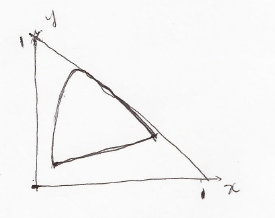| Line 59: | Line 59: | ||
d) | d) | ||
If <math> (X,Y,Z)=(0,1/2,1/2) </math>, then <math> (x,y)=(0,1/2) </math>. [[ Image:Pro1_d.PNG ]]<br /> | If <math> (X,Y,Z)=(0,1/2,1/2) </math>, then <math> (x,y)=(0,1/2) </math>. [[ Image:Pro1_d.PNG ]]<br /> | ||
| − | In the chromaticity diagram, this point is outside the horse shoe shape, | + | In the chromaticity diagram, this point is outside the horse shoe shape, so its RGB values are not all larger than 0 (<math>R<0,G>0,B>0</math>). |
e) We are likely to see quantization artifact in dark region. | e) We are likely to see quantization artifact in dark region. | ||
| Line 86: | Line 86: | ||
d) This color is imaginary. At least one of R,G,B values must be negative. Cannot be produced by this device. [[ Image:Pro1_d2.PNG ]]<br /> | d) This color is imaginary. At least one of R,G,B values must be negative. Cannot be produced by this device. [[ Image:Pro1_d2.PNG ]]<br /> | ||
| + | |||
| + | <span style="color:green"> The student can be more specific about the positive or negative of each R,G,B value of this color. </span> | ||
e) Quantization artifacts in the dark area. | e) Quantization artifacts in the dark area. | ||
Revision as of 20:47, 20 March 2013
Contents
ECE Ph.D. Qualifying Exam: CS-5 (637)
- Problem 1 , 2
Problem 1
Consider the emissive display device which is accurately modeled by the equation
$ \left[ {\begin{array}{*{20}{c}} X\\ Y\\ Z \end{array}} \right] = \left[ {\begin{array}{*{20}{c}} a&b&c\\ d&e&f\\ g&h&i \end{array}} \right]\left[ {\begin{array}{*{20}{c}} R\\ G\\ B \end{array}} \right] $
where R, G and B are the red, green, and blue inputs in the range 0 to 255 that are used to modulate physically realizable color primaries.
a) What is the gamma of the device?
b) What are the chromaticity components $ (x_r,y_r), (x_g,y_g) $ and $ (x_b,y_b) $ of the device's three primaries.
c) What are the chromaticity components $ (x_w,y_w) $ of the device's white point.
d) If $ (X,Y,Z)=(0,1/2,1/2) $, then what can you say about the values of $ (R,G,B) $? (Hint: Draw a chromaticity diagram to find the answer.)
e) Imagine that the values of $ (R,G,B) $ are quantized to 8 bits, and that you view a smooth gradient from black to white on this device. What artifact are you likely to see, and where in the gradient will you see it?
Solution:
a) $ \gamma=1 $
b)
$ (x_r,y_r)=(\frac{a}{a+d+g},\frac{d}{a+d+g}) $
$ (x_g,y_g)=(\frac{b}{b+e+h},\frac{e}{b+e+h}) $
$ (x_b,y_b)=(\frac{c}{c+f+i},\frac{f}{c+f+i}) $
c)
$ (x_w,y_w)=(\frac{a+b+c}{a+b+c+d+e+f+g+h+i},\frac{d+e+f}{a+b+c+d+e+f+g+h+i}) $
d)
If $ (X,Y,Z)=(0,1/2,1/2) $, then $ (x,y)=(0,1/2) $.
In the chromaticity diagram, this point is outside the horse shoe shape, so its RGB values are not all larger than 0 ($ R<0,G>0,B>0 $).
e) We are likely to see quantization artifact in dark region.
Solution From Another Student:
a) The gamma is 1
b)
$ (x_r,y_r)=(\frac{a}{a+d+g},\frac{d}{a+d+g}) $
$ (x_g,y_g)=(\frac{b}{b+e+h},\frac{e}{b+e+h}) $
$ (x_b,y_b)=(\frac{c}{c+f+i},\frac{f}{c+f+i}) $
c)
$ (x_w,y_w)=(\frac{a+b+c}{a+b+c+d+e+f+g+h+i},\frac{d+e+f}{a+b+c+d+e+f+g+h+i}) $
d) This color is imaginary. At least one of R,G,B values must be negative. Cannot be produced by this device.
The student can be more specific about the positive or negative of each R,G,B value of this color.
e) Quantization artifacts in the dark area.



